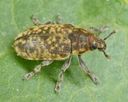Rhinocyllini
Rhinocyllini
Classification
- Phylum: Arthropoda
- Subphylum: Hexapoda
- Class: Insecta
- Order: Coleoptera
- Suborder: Polyphaga
- Superfamily: Curculionoidea
- Family: Curculionidae
- Subfamily: Lixinae
- Tribe: Rhinocyllini
Pronunciation
How to pronounce Rhinocyllini: /riːnɔsɪˈlaɪnaɪ/
These audio files are automatically generated. While they are not always 100% accurate, they are a good starting point.
Images






Summary
Bangasternus fausti, known as the broad-nosed seed head weevil, is an introduced species in North America utilized for biological control of invasive knapweeds. It is native to Europe and the Middle East and specifically targets invasive plant species without harming native flora.
Physical Characteristics
The adult weevil is dark gray and hairy, measuring about 4 millimeters long.
Identification Tips
Look for the distinct broad nose shape characteristic of true weevils.
Habitat
Primarily associated with flower heads of knapweed species and their stem tips.
Distribution
Native to southern Europe and the Middle East; introduced and established in the Pacific Northwest of North America.
Diet
Larvae feed on the developing seeds of knapweed species, often consuming them entirely.
Life Cycle
The female lays eggs on flower heads and stem tips. Larvae burrow into the flower heads and feed on seeds, then pupate inside the seed head.
Reproduction
Female weevils lay eggs on young flower heads and stem tips.
Ecosystem Role
Acts as a biological control agent against invasive species of knapweeds.
Economic Impact
Used in biological pest control to combat noxious knapweeds, reducing their impact on agriculture and native ecosystems.
Tags
- weevil
- biological control
- invasive species
- knapweed
- Coleoptera
- Rhinocyllini